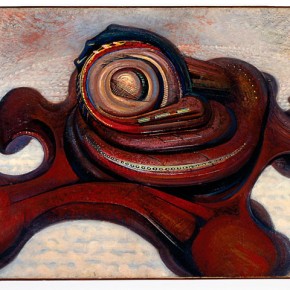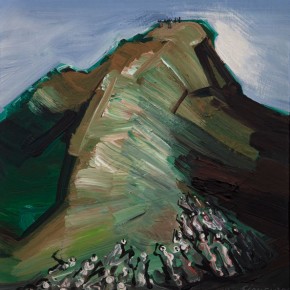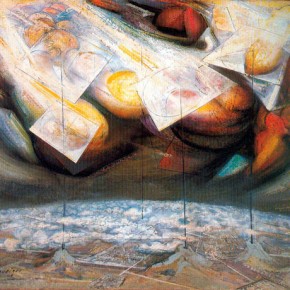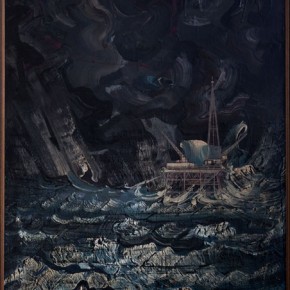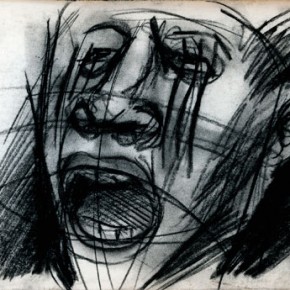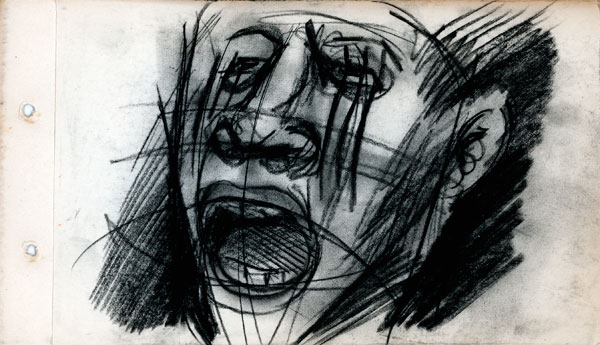
David Alfaro Siqueiros, Studies, 1941-1942.Thirteen charcoal and conte crayon drawings on paper, leather and copper bound sketchbook. Gift of Frank Mainzer and Lonnie Zwerin, M.2008.018. Four Views from the MOLAA Permanent Collection.
Artist and political activist, David Alfaro Siqueiros (1896 -1974), was a vital member of the Mexican School of Painting along with Diego Rivera and José Clemente Orozco. He continues to be viewed as one of the most important Mexican artists of the twentieth century while his artistic influence spread far beyond Mexico’s borders.
Siqueiros was not only a member of the Mexican Communist Party and veteran of the Mexican Revolution and Spanish Civil Wars, he also fought vigorously for the rights of laborers and on several occasions his political activities put him in jail and even led to exile. Throughout his life, he advocated the ideal that art, by its nature, had to be political in order to carry any substance, and that mural art should be used as a public service for el pueblo (the community). Siqueiros went, perhaps, the furthest of all the muralists in his attempts to combine his political views and aesthetic ideals with modern technical means to create a truly “public art.” Declaring his artistic and political views in public, arguing endlessly at conferences and in his writing, and organizing artists and architects in both Mexico and abroad to promote the idea of creating collective works.
In addition to his exploration of techniques and styles, Siqueiros constantly experimented with new tools and materials.
Largely due to his mural painting, Siqueiros is represented in the historic standard of modern Mexican art as one of the leading proponents of public art for social action. But as an artist, it was through his easel painting that he studied an extensive variety of techniques and styles that allowed him to examine illustrative space, composition, light, shadow and color. After discovering various types of industrial materials produced in the United States in the 1930s, Siqueiros’ produced most of his easel works with uncommon materials which include Duco paint, a DuPont brand name for pyroxilin paint, a tough and resilient type of nitro-cellulose paint manufactured for the automotive industry. Also utilized was vinylite paint, a type of lacquer with a vinyl base used for easel paintings or as a primer for mural works. Rarely working on canvas, Siqueiros preferred to paint on various types of composite wood surfaces such as Masonite, because of its low cost, ease of preparation, durability and receptiveness to pyroxilin and acrylic paints. The use of these industrial materials, not commonly used as “fine art” materials, again emphasizes the radical nature with which Siqueiros produced his art.
Over the years, the toxic pyroxylin paints that he used had taken a toll on his health, but did nothing to change his political sympathies. He continued to attend protests, speak at meetings, file petitions and fought endlessly against the injustice of the Mexican political system and society. Though the painter continued to be productive through the end of the 60s and early 70s, he was already very ill with prostate cancer. A strong and stubborn man, however, Siqueiros refused to see the doctors, until the pain became too severe to endure. He was diagnosed in May 1973, by which point little could be done to help him. The verdict was given to him beneath his own mural, Defense of the Future Victory of Medical Science over Cancer (1958), painted more than a decade earlier.
David Alfaro Siqueiros died eight months later in January 1974, putting a cap on a long and adventurous life. Hundreds of people from all walks of life attended his funeral, including fellow artists, politicians, political comrades and simply admirers of his art. He was interred in the Rotonda de los Hombres Ilustres en el Panteon Civil de Dolores (Rotunda of Famous Men of the Civil Pantheon of Mourning), in Mexico City, a site that honors those who are considered to have exalted the civic, national and human values of Mexico. The Rotunda contains the remains of three former presidents, many heroes from the Mexican Revolution, as well as politicians, musicians, poets, writers, journalists, painters, intellectuals, educators, scientists and military men.
-originally published December 2010
- David Alfaro Siqueiros, Pedregal con figuras / Rocks with Figures, 1947. Pyroxilin on masonite, 39 3/8 x 48 1/16 in. Acervo Instituto Nacional de Bellas Artes y Literatura / Museo de Arte Alvar y Carmen T. de Carrillo Gil, Mexico.
- David Alfaro Siqueiros (Mexico, 1896-1974) Aeronave atómica, 1956. Piroxilina sobre madera, 98 x 122 x 19 cm. Colección Museo de Arte Carrillo Gil, INBA.
- David Alfaro Siqueiros Anhelo, cárcel preventiva / Desire, Preventive Jail, n.d. Acrylic on masonite, 14 x 14 in. Private Collection, Mexico.
- David Alfaro Siqueiros (Mexico, 1896-1974) Antenas estratosféricas / Stratospheric Antennas, 1949. Pyroxylin on masonite / Piroxilina sobre masonite, 100 x 123 x 20 cm. Instituto Nacional de Bellas Artes y Literatura, Museo de Arte Carrillo Gil, Mexico.
- David Alfaro Siqueiros, El árbol de la noche triste, Estudio para mi mural de Chapultepec, Octubre de 1962 / Sad Night Tree, Study for Chapultepec Mural, October 1962 . Acrylic on masonite, 23 5/8 x 17 11/16 in. Private Collection, Mexico.
- David Alfaro Siqueiros El petróleo en México / Petroleum in Mexico, 1967. Acrylic on masonite, 48 1/16 x 35 7/16 in. Guillermo Fridman Collection, Mexico.
- David Alfaro Siqueiros, Cain en los Estados Unidos / Cain in the United States, 1947. Piroxilina on Wood, 76 x 92.8, Acervo CONA CULTA-IN BA / Museo de Arte Alvar y Carmen T de Carillo Gil, INBA.
- Untitled, David Alfaro Siqueiros, Studies, 1941-1942. Thirteen charcoal and conte crayon drawings on paper, leather and copper bound sketchbook. Gift of Frank Mainzer and Lonnie Zwerin, M.2008.018. Four Views from the MOLAA Permanent Collection.
- David Alfaro Siqueiros, Studies, 1941-1942.Thirteen charcoal and conte crayon drawings on paper, leather and copper bound sketchbook. Gift of Frank Mainzer and Lonnie Zwerin, M.2008.018. Four Views from the MOLAA Permanent Collection.


